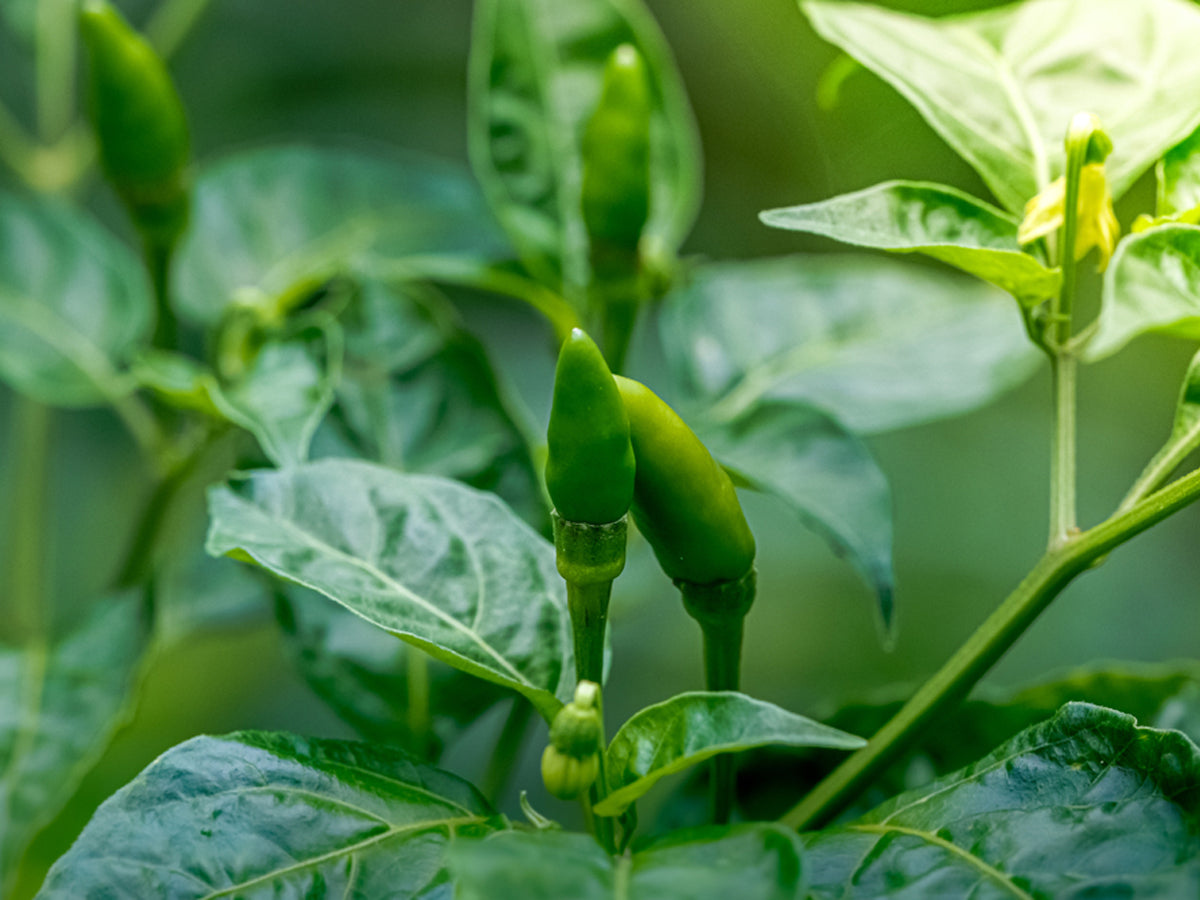How to Grow
How to Grow Mirchi at Home – Know Super Easy Steps
The hotness of anything is usually compared to this tall or small, slender, and spicy vegetable.
There is a famous radio channel in our country by it's name, and the tagline is “It’s hot.”
Be it red or green, their primary work is to enhance spiciness in your food.
Obviously, we are referring to chili or mirchi. Indian, Mexican, and Thai cuisines are incomplete and impossible without chilies. Mirchi is both a taste enhancer and a seasoning.
Have you noticed that be it Mexico or India – the most popular chili-eating zones are both hot and humid? Because perspiration is produced after the consumption of chilies and has a cooling impact on the body, chilies are commonly found in hot and humid environments.
Chili is required every day at home, from breakfast to dinner recipes. So, growing it at home would be a smart idea. We will provide you with information about growing chilies at home. Here is a list of what we will discuss: -
- Interesting facts about Mirchi or chili
- How to grow Mirchi or Chili plants at home easily
- How to take care of Mirchi or Chili plants
- Key health benefits of Mirchi
So, let’s get started and know the spicy chili.
Interesting Facts about Mirchi or Chili
- Mirchi or chilis are varieties of the berry-fruit of Capsicum plants.
- Chili peppers or mirchi are members of the nightshade family Solanaceae, which also includes tomatoes, potatoes, eggplant, and so on.
- Capsaicin and related chemicals known as capsaicinoids are what gives chili peppers their heat.
- Do you know that the spicy compound in chili peppers known as capsaicin is used as an analgesic in topical creams, nasal sprays, and dermal patches to treat pain?
- It’s interesting to learn that a 2022 review of preliminary research says that regular consumption of chili peppers is linked to modest evidence of a decreased risk of mortality from cancer and cardiovascular disorders.
- Contrary to popular belief, oranges do not have the highest vitamin C content among all foods. While mirchi has 143.7 mg of vitamin C per 100g, an orange contains only 53.2 mg.
- India is one of the largest producers and consumers of chilies, besides China, Mexico, Peru, and Spain.
How to Grow Mirchi or Chili Plants at Home easily
Mirchi is a necessary item in all our foods, so growing a mirchi plant isn't a bad idea. Remember that the key to successfully growing a chili plant is to ensure it gets plenty of light, heat, moisture, and humidity. Below is an explanation of how to grow the hari mirchi plant indoors: -
Seed Germination
- Take a seed starter tray and fill it up with soil. Since chili seeds don't need to be sown very deeply, fill the cell to the top.
- Rich soil-based compost is a fantastic soil option for chili plants. A potting mix that includes vermiculite or perlite is a good option because chili plants require adequate drainage.
- The time of year you plant doesn't matter because you're growing the chilies indoors.
- Put two or three seeds in the tray and then add a thin layer of additional potting soil or compost over the seeds.
Watering the seeds
- You have to keep the soil moist and water the seeds.
- Water the soil after the seeds have been placed for faster germination.
- Remember that the soil has to be moist, not soggy.
- The seeds will sprout in two to four weeks.
Cover the seed tray
- Covering the seed tray will help keep heat and moisture inside and promote germination.
- Take a clear plastic bag for this purpose.
Keep the tray in dark
It's crucial to put the seeds somewhere relatively dark with some filtered light while they are germinating. Additionally, make sure the temperature is higher than 18.3 degrees Celsius. The ideal location is a shed or garage with a window. You have to keep the seeds this way until they sprout.
Remove the cover
- Remove the plastic bag from the tray when you see sprouts.
- Move the tray to a cozy space with a window that will give the sprouts plenty of indirect light, such as a warm room with a skylight or a bathroom.
- Use a fluorescent tube light instead of a window if you don't have one to encourage the growth of your plants.
Transplanting time
When you see that the young sprouts have developed two to four sets of leaves, you have to prepare for transplant. Also, check your sprouts regularly for leaf growth as they mature.
Thin the weaker seedling
Determine which of your seedlings is the strongest and healthiest. Keep an eye out for taller stems, more leaf growth, and fuller leaves. Either trim the weaker seedling with scissors at the soil line or pinch it off with your fingers to remove it.
Prepare the chili plant pot
- Fill a small pot with potting soil and place the chili plants inside.
- Bring a three-inch-wide pot and transplant the chili seedlings carefully.
- Use a mixture of sphagnum moss and old manure, or 2 inches of rich, high-quality potting soil.
Carefully transplant
- Turn the seed starter tray over while placing your palm over the seedling's base.
- Without damaging the roots, carefully remove the seedling and root ball from the starter tray. You can gently squeeze the seed cell to break up the soil and roots.
- Transfer the seedling to the larger pot you prepared.
- Include just enough soil to cover the stem from the first set of leaves down.
Further care
- Choose a sunny window or warm location to keep the pot.
- Moisten the soil when it feels dry.
- Fertilize every two weeks by feeding the plant with a combination of a balanced fertilizer with some water.
Harvest
- Around three months after your transplant, you will see fresh chilies gracing your plant.
- Your chilies could range in length from an inch to eight inches, depending on the variety you choose.
- Harvest ripe chilies by using a knife or pair of scissors to trim the stem slightly above the fruit.
How to Take Care of Mirchi or Chili plants
Read below and know how to take care of mirchi plants at home: -
Sunlight
Chilies originated in Central and South America. They were cultivated first in Mexico, which is a hot and humid place. So, this plant loves plenty of sunshine. Ensure at least four to six hours of daily sunlight.
Location
Choose a location in your home that receives optimum sunlight and is warm enough to offer a hospitable environment for the growth of chilies.
Soil
Because chili plants cannot endure prolonged exposure to water, the soil should be permeable. Sandy loam or black soil works best for Mirchi plants. You can also use organic potting soil and incorporate some vermicompost into it.
So, the ideal soil for chili plants is well-draining, porous, rich in nutrients, and has a pH between 6.5 and 7.5.
Water
Water only when the top layer of the soil appears dry because chilies don't need as much water as other plants do. Always check the soil before watering to avoid overwatering.
Fertilizer
Apply organic fertilizer to your plants regularly. Use cow dung, composted tea leaves, fruit peels, etc. Your plants will grow successfully if the soil is mineral-rich.
Temperature
Warm and humid conditions are ideal for the growth of chilies. The perfect temperature for growing chilies is between 22 and 25 degrees Celsius.
Pruning
You can prune the plant after the fruiting season has passed.
Mulching
When cultivating mirchi plants, mulching the soil is quite helpful since it preserves soil quality and keeps the topsoil moist.
Diseases
Numerous diseases, including anthracnose, fruit rot, leaf spot, powdery mildew, mosaic disease, bacterial wilt, dieback, etc., can affect chili plants. Pests such as thrips, aphids, spider mites, nematodes, pod borers, grubs, etc. may also attack it.
- As a remedy, plant onions because that will naturally reduce the frequency of insect assaults.
- Neem cakes are applied to prevent grubs.
- Apply neem oil once a week for the prevention of diseases.
- Remember that nutrient-rich soil will aid in worm or any disease prevention.
Key Health Benefits of Mirchi
You'll be hard-pressed to find an Indian home that doesn't use chili or mirchi in their dishes. Some use more because they love spicy food, while others use less. In some places, vendors even offer mirchi for “free” if you have purchased multiple vegetables from them.
Take a look at the nutritional chart (100gms of green chilies) and probable health benefits of mirchi: -
|
Calories |
40 |
|
Carbohydrates |
9g |
|
Calcium |
18mg |
|
Fat |
0.2g |
|
Fiber |
1.5g |
|
Iron |
6% of the RDI |
|
Magnesium |
6% of the RDI |
|
Potassium |
340mg |
|
Sodium |
7mg |
|
Phosphorus |
46mg |
|
Vitamin A |
2g |
|
Vitamin C |
242mg |
Rich source of antioxidants
Chilies are a rich source of antioxidants like vitamins A, B complex (B6 and B9), and C, which greatly aid in preventing blood clots. A blood clot is the most common cause of cardiovascular problems such as heart attacks and cardiac arrest. Antioxidants fight free radicals and aid in preventing the spread of cancer to the lungs, prostate, and colon.
Natural immunity booster
Having vitamin A-enriched chilies means you are blocking germs and infections from entering your body. Vitamin C, on the other hand, aids in the formation and maintenance of connective and cardiovascular tissues. There is high quantity of vitamins A and C in chilies, making them a natural immunity booster that helps us combat major diseases and recover faster even when sick.
Helps lose weight by improving metabolism
When you eat chilies, you feel the heat, and that process is known as thermogenesis. It makes your metabolism work harder. So, you may speed up your metabolism and cause your body to burn more calories.
Anti-inflammatory in nature
With anti-inflammatory properties, lal mirchi or hari mirchi aid with the pain and swelling associated with terrible bone ailments, including osteoarthritis, rheumatoid arthritis, and others.
Better digestion
Because it contains a lot of vital dietary fiber that aids in colon cleansing, eating chilies in moderation helps better digestion. It promotes regular bowel motions and guards against constipation.
Stronger bones and teeth
Chilies are one of the best sources of calcium and support the health and strength of our teeth and bones. Additionally, it aids in the production of new blood cells and tissue repairs.
Apart from these aforementioned benefits, chilies also have antibacterial properties to guard against colon infections, athlete’s foot, and herpes zoster. Chilies may also help improve vision. Who wouldn’t want to give chili plants a permanent place in their homes? You need simple things to get started, and taking care of this plant is also easy. Wear your gardening gloves and grow chilies at home.
Happy gardening!
FAQs Related to Chili or Mirchi
How spicy are mirchi or chili?
The heat of mirchi or chili can vary widely, depending on the variety and how they are prepared. Some are very mild, while others are extremely spicy.
How long does it take the mirchi plant to grow?
The time it takes for a Mirchi or Chili plant to grow can vary depending on the specific variety of Mirchi, growing conditions, and other factors. Generally, it takes about 2–3 months for the plant to reach maturity and produce fruit.
Which is the best fertilizer for a mirchi plant?
Besides compost, potassium- and phosphorus-rich fertilizer is good for more flowers and fruits. A balanced NPK (nitrogen, phosphorus, and potassium) fertilizer with a higher ratio of phosphorus and potassium, such as a 5-10-10 or 10-10-10 fertilizer can be a good choice for Mirchi plants.
How much sunlight is good for the growth of chili plants?
Mirchi or Chili plants require full sun to grow and produce fruit. They need at least 6-8 hours of direct sunlight per day.
What is the lifespan of chili plants?
In optimal conditions, chili plants may live up to eight to ten years.



